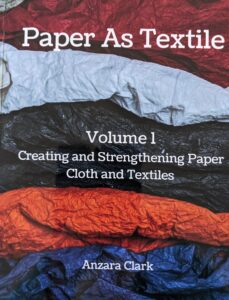SDA Book Club: Paper as Textile reviewed by Zia Gipson
November 1, 2024
Paper as Textile by Anzara Clark

The Australian artist, educator and author Anzara Clark, through her two-volume series Paper as Textile, presents quotidian, universal and culturally pervasive paper as a sculptural and expressive medium for its innate flexibility, adaptability, and endless versatility. In Clark’s books, artists and craftspeople are given a sort of classroom-in-a-book through which they can find detailed and thoughtful information about working with paper as something other than a substrate. These books provide a much welcome advanced written and visual course about using paper to make the flat as well as three dimensional art forms artists imbue with meaning and significance.
Clark’s two books, published in 2023 (Volume 1) and 2024 (Volume 2), are comprehensive in their discussions, especially in making a variety of garment-like forms. The books are practical and it’s clear Clark has spent many hours studying a variety of textile and basketry techniques pertinent to paper (think joomchi, crochet, knitting, weaving, plaiting, etc.) Clark admits to being an experimenter, the better to find multiple means to address structural issues. For example, in Volume 2 she has documented methods to strengthen/reinforce, append, attach, and otherwise bend paper to expressive form. She includes a primer on making a variety of bases and foundations such as armatures and papier mâché.
Good photography is key, and many of the books’ technical discussions have clear photographic illustrations to accompany her lessons. The book’s internal design reflects her teaching objectives by using sets of bullet points to summarize and reinforce the important points from the text. Other helpful aids are bibliographies, appendices and indices, as well as tables of content allowing the reader to zero in on exactly the section most relevant to their inquiry.
In Volume 1, I was especially attracted to the discussion of joomchi, or felted paper, as it is sometimes known, since that’s been the focus of the sculptural work I’ve been engaged in for over a decade. However, I dispute one statement in this part, “Paper made from paper mulberry fibres is an essential inclusion for success with joomchi…”. My personal experience is that any long fiber paper will work fine in making joomchi. I’ve used all of the traditional paper types (mitsumata, gampi and paper mulberry), solo and in combination, as well as abaca, and had the papers fuse readily. It may be that Clark considers paper mulberry the best of the paper fibers because it’s an easier paper to felt, but I have yet to test paper types this way.
Having had these books in hand for several months I keep finding useful information that will make my paper objects more structurally sound and content rich. I offer an especially big thank you to Clark for completing what must have, at times, felt like a monumental undertaking. She’s an inspiration as an artist and educator and I look forward to continuing to follow her efforts wherever they may take her.
–Zia Gipson | ziagipson.com
- Publisher: Self published (buy it here)
- Date: November 2023
- Volume 1 Creating and Strengthening Paper Cloth and Textiles
- Volume 2 Using Paper Textiles for Creative Projects and Garment Forms
If you’ve read this book, leave a comment and let us know what you think!
Do you have a recommendation for a recent fiber-related book you think should be included in SDA’s Book Club? Email SDA’s Managing Editor, Lauren Sinner, to let her know!
